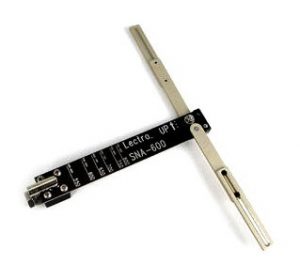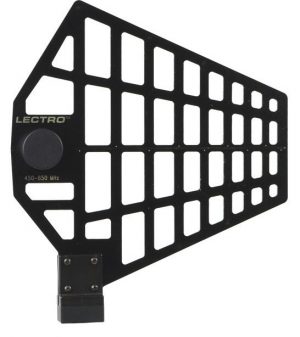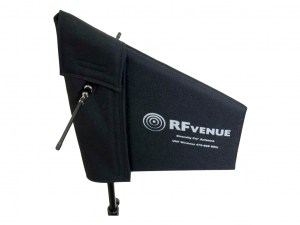Dipole vs Sharkfin vs Polarized Diversity (Diversity Fin)
A new antenna called the “Diversity Fin” (polarization diversity), made by the company RF Venue, has been getting enough attention to warrant a comparison with two other popular antenna designs, the dipole and the “Shark Fin” (log periodic).
For the purpose of this comparison, the assumption is that these antennas will be used on diversity receivers. Dipoles and shark fin antennas were used in pairs (a pair of dipoles was compared to a pair of shark-fins), and these were compared to one diversity-fin since this antenna is actually two antennas (A and B) built into a single device.
It should be mentioned that the diversity fin is a combination of a shark-fin and a dipole in a single device, arranged so that the shark-fin has a vertical polarization and the dipole has a horizontal polarization. The two antennas in the diversity-fin are polarized 90 degrees from each other.
Starting with the simple “whip” antenna (not used in this comparison) there are pros and cons to each of these antenna types:
Simple Whip

The whip antenna is simple, cheap, and it is convenient in that it mounts directly to the receiver chassis, which acts as the antenna’s “ground plane”, which is required for a whip antenna. The need for a ground plane is the reason it is not practical to position a whip antenna on a mast away from the receiver with an extension cable. The whip antenna is omni-directional around its axis. For wireless microphone use, the whip antenna is usually cut to ¼ wavelength, which, for commonly used UHF frequencies, is typically about 3 to 5 inches.
Dipole

A dipole antenna, basically, combines two ¼ wavelength whip antennas, pointing opposite directions (up and down, for example), with a single cable connector between them. Compared to the simple whip antenna, the dipole has the advantage of not requiring a “ground plane”, which allows it to be mounted strategically away with an extension cable. The dipole antenna is omni directional around its axis.
Log Periodic (shark-fin)

This antenna is often laid out on a thin flat circuit board, with its antenna beams created as traces on the circuit board. Since the beams get smaller towards the front of the antenna, it takes on a triangular shape resembling a shark’s fin. The log periodic antenna is directional, much like a shotgun microphone. When the antenna is pointing towards the transmitter, the received signal is increased, and when pointing away from the antenna, the signal is decreased. Generally, pointing anywhere from directly at the transmitter to less than a right angle away from the transmitter does not cause an appreciable amount of signal attenuation. However, pointing away from the transmitter at angles of 90 to 180 degrees causes up to approximately 8dB of attenuation, which will have a significant affect on reducing the range of useful reception.
Polarization Diversity (Diversity Fin)

This antenna is two antennas: a shark fin with a dipole mounted on it, and has connectors for the A and B inputs of a diversity receiver. The practical advantage of this antenna design is that it is a single device for a diversity receiver. While it can be said that it combines the advantages of the two antenna types (the directionality of the shark fin with the omni-directionality of the dipole) it also combines the disadvantages of the two antenna types (the rear rejection of the shark fin and the lack of gain of the dipole). This antenna design is probably best used with what is mischaracterized as “true diversity” systems, where the receiver selects only the antennal with the best signal. However, when used with “antenna-diversity” receivers such as the popular portable Lectrosonics portable receivers that always combine the two antennas, inverting the B antenna when it improves combined signal strength, the Diversity Fin antenna can reduce the combined signal strength at the receiver. In practical applications in the real world, multipath reflections often make the polarization of received signals rather arbitrary, so this disadvantage may not be a factor very often. However, this antenna design guarantees that the combined signal of the two antennas will never be as strong as two individual antennas polarized the same (both vertical, for example) and happen to be in the ideal position for a transmitted signal.
Practical Comparison Test
In the end, while the theory may be interesting to some, the only thing that matters is how the antennas work in actual field use, and what matters with wireless microphone performance is long range and stability. Comparing the performance of three antenna types (dipole, shark-fin, and polarization diversity) using a Lectrosonics SMa transmitter and Venue receiver, the results of walk-tests were consistent with the theory. The environment involved a lot of multipath reflections. The receiver was inside a steel rod-reinforced concrete building, and the transmitter was outside, gradually moving away. There was not a huge difference between the maximum range any of them. They all went about 250 feet without dropouts (very respectable given the obstacles of the building), with the Diversity Fin going about 20 feet further than the dipole, and the shark-fin going about 20 further than the Diversity Fin. Keep in mind that this comparison was with the directional antennas pointing toward the transmitter. When they were pointing the other direction, the order of performance was completely reversed, with the dipole being the winner.
My Opinion
Each antenna could be the best choice, depending on the application. For the majority of the situations that I have worked in production, my preference is for the dipole (specifically, the folding dipole by Lectrosonics). It is the least expensive, the most compact, performs more than adequately for most situations, and they cannot be pointed in the wrong direction when positioned vertically. The shark-fin is the preferred choice when the wind is not strong enough to turn them, the bulkiness is not a factor, when the price is within budget, when the extra gain is needed, and when its certain they can be pointed in the right direction. The choice might favor the new polarized diversity antenna design (Diversity Fin) when its lower price (compared to two separate antennas) is enough of a factor, when having a one-piece antenna is important, when it is certain it can be pointed towards the transmitters, and particularly when used with “true diversity” receivers such as is common from manufacturers Shure, Sennheiser, and Zaxcom (which does not include most portable diversity receivers made by Lectrosonics).
19 comments
Leave a reply Delete Message
You must be logged in to post a comment.


 US
US  Canada
Canada 


Thank you soooooo much for this!
I tested a number or radio mike antennas for the 695 Quarterly. The tests are available at: http://695quarterly.com/previous-issues/
(Spring 2010, Fall 2010, Winter 2011, Spring 2011 and Summer 2011)
I made three observations that are relevant to this inquiry:
1. Performance differences, while measurable, are fairly small. The range of one design will exceed another by only 10% or 20%.
2. Best to worst performance was: Yagi, log-periodic and helical (a tie), tuned dipole (e.g. SNA-600) and simple whip.
3. Maximum performance is achieved only when matching antennas are used. Mixing designs yields the performance of the weaker link. Combining a log-periodic with a whip yields only slightly better performance than just whips. At the range limit of the lower gain antenna, the signal becomes more susceptible to hits and drop-outs.
From that experience, I would regard the Polarized Diversity antenna as an inherently limited design. It may have some use in an application where deploying discrete antennas is cumbersome or not possible but it's a deliberate choice of expediency over performance.
in your experience what is the best solution for a bag sound kit with 2 ucr 411 and 3 g3 sma modded? to improve the range but also being comfortable is better sharkfin antennas or dipole (with passive splitters or multisma box)
Hi David. Thanks for your input. Sounds like your results were the same as mine. Good to be validated :)
GT
Very interesting topic indeed. Just wondering what is the point to make that Diverse-Fin if it lost with the practical test anyway? I think it's not really practical in the end and not that diverse either.
Hi Kirill,
Advantages would include price and convenience, but not necessarily performance.
Interesting. How much did you pay for the Diversity fin?
Interesting. How much did you pay for the Diversity fin?
Hi Gus. The list price is $399. I see it's not on the Trew Audio online store yet (will be very soon, I'm sure). Until then, a call to the Trew Audio sales department will tell you if that is the actual selling price.
Glen Trew
I've often wondered how the Diversity Fin compared to the other setups. I use mine for reality in a bag as a kind of 'mobile cart' where I have to be on stand-by to run away to chase talent. It's never practical to have 2 shark fins, but the dipole seems like it would be a good option as well, but I like the option of just a single unit on my bag. Not much of my time is spent with my rig strapped on, so it works well in both situations. I wonder, would turning the dipole antennae vertical have a positive or negative effect on performance?
In the real world we usually work in, where multiple reflections render the transmitted signal's polarity to be rather arbitrary, you would probably notice very little difference between pointing your antennas vertically or horizontally. However, since most people where the bodypack transmitter with the antenna vertical, the odds are in your favor to have both receiver antennas vertical, particularly with antenna diversity systems like the portable Lectros. With the Diversity Fin, one will always be polarized 90 degrees from the other.
Hi Glen,
I see on live event productions 2 other antennas, helicals and just recently dome helicals being used. Are these used in film/television and do you have any comments compared to the others you tested above?
Re David Waelder's post:
"3. Maximum performance is achieved only when matching antennas are used. Mixing designs yields the performance of the weaker link. Combining a log-periodic with a whip yields only slightly better performance than just whips. At the range limit of the lower gain antenna, the signal becomes more susceptible to hits and drop-outs."this clears up a problem I had in two shows recently. I had only one dipole antenna running on a Lectro 411 receiver (I just used the whip on the other side) and experienced occasional signal drop. I was under the mis-conception that only one dipole was required. We're going back in studio soon and this time I'll install two dipoles. I anticipate stellar reception!
Question: With 2 dipoles on a single 411 would it be wise to orient one horizontally and one vertically? Would it make no difference?
How does the range of detection compare for 6-9 kHz signals and compared to the Sennheiser shotgun microphone? Does one design provide a better SNR in wind and situation of sidelobe interference?
Is one design better for weatherproofing?
I too am interested in the combined horizontal and vertical dipole antennae
Thanks,
Rhonda
Hi Glen,
Thanks for doing this; the results were very interesting. What are the differences between an active shark fin, to that of a passive?
Some antennas have an amplifier attached to compensate for signal loss caused by long cable runs. These amplifiers (whether built onto the antenna or in a separate box) are usually phantom powered with DC voltage from the receiver.
Glen Trew
That's cleared that up. Thanks Glen.
I saw the Diversity Fin at Infocomm (and a lot of other very cool stuff) and now, I understand it. The thing is not about gain, or distance. it is about dropouts, reducing them, due to nulls that can not be fixed by two paddles.
Hi Glen
Great review. I would like to ask if the ALP 500 Lectrosonics Log Periodic antennas are any difference from other manufacture passive LP antennas considering that they both are in the same frequency range.
Mario